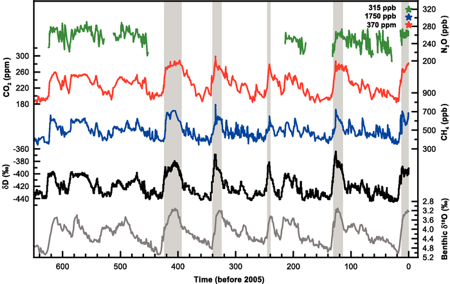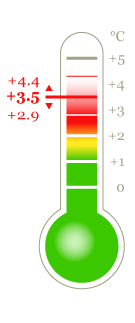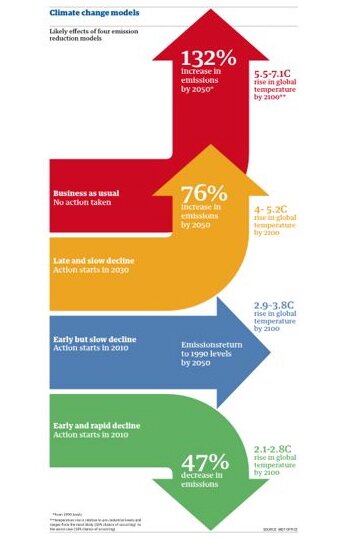WHY CLIMATE CHANGE
IS AN EMERGENCY
Global climate change has become a real and increasing threat
to the very survival of humanity.
It is already a growing emergency for regionally
vulnerable populations.
An estimated 400,000 people a year are being killed as a result of global climate change (DARA Climate Vulnerability Monitor 2012)
Reasons Why Climate Change is an Emergency
COMMITMENT
The biggest reason is today's already committed (locked) global climate change. International emissions policy commits us to 3.5C by 2100 (Climate Interactive). The international policy target of 2.0C is planetary disaster and without an emergency response now we are committing humanity to a warming above 2.0C. Climate system inertia is an absolute commitment of 1.5C by 2030-2040 (IPCC AR5 WG2), which is disastrously dangerous to billions of people alive today, to world food security for all of us, and to all future generations

Today's levels of atmospheric GHGs and their rate of increase, is proof of the planetary emergency. The levels are far above the maximum recorded by ice cores going back 800,000 years. The main GHG, CO2 at 400 ppm is now 30% higher that its 80,000 yr maximum of 300ppm. Methane at 1860 ppb is more than double its maximum of 800ppb.
Atmospheric CO2 is increasing at a dramatic and unprecedented rate. This is clear from the abrupt increase of all GHGs over the past 10,000 years following fossil fuel industrialization. The record of the past 300 years shows the increases are exponential, and the record of the past 10 years shows the acceleration is continuing.
These atmospheric GHG levels constitute a long term commitment of 2.0C (IPCC AR5 WG1).
The abrupt GHG increase correlates directly with radiative, which is also abrupt. The biosphere is being heated at an abrupt unprecedented rate.
The unprecedented rate of CO2 increase is the main cause of the fact that today's global temperature in increasing at least 10 times faster than the past 65 million years (NRC Abrupt Climate Change 2012). The global warming of 1C is now outside the 10,000 year range of the agricultural era.

Global climate change danger limit.
The IPCC AR4 and AR5 assessments show that the danger limit is 1.0C.


Atmospheric CO2 safety. One reason that climate change has become an emergency is that today's atmospheric carbon dioxide concentration is 400 ppm, when it is now recognized that this level must be below 350 ppm to avoid a future commitment global climate catastrophe.
As it is we already are finding the planet is more sensitive to today's warming than expected, most dramatically shown by the rapid rate of the Arctic summer meltdown.
Other reasons for the emergency call:
- Climate change commitment (locked in additional warming) is 1.5C by 2030-2040 (IPCC AR5 WG2). Long term commitment due to today's atmospheric GHG levels is 2.0C (IPCC A5 WG1).
- Though most nations Parties in the UN negotiations want a limit under 1.5C with immediate action on emissions, 2.0C remains in the negotiations. 2.0C is planetary disaster (J. Hansen et al 2013)
- The Post Paris Agreement May 2016 UN Update of national emissions targets estimates global emissions will be 16% HIGHER in 2013.
- All energy plans are for continued business as usual fossil fuel energy dominance and dependence. The US 2013 EIA forecast estimates global carbon energy emissions will increase 46% by 2040.
- Global greenhouse gas emissions have been increasing at an exponential rate.
- All atmospheric greenhouse gas concentrations are increasing faster than ever.
- Extreme weather events like heat waves, drought,torrential rains, and floods are increase because of global climate change. Disastrous such extreme events have affected every continent, and has caused crops losses to the worlds best food producing regions in the northern hemisphere.
- The Arctic temperature is increasing fast, at 3-4 times the global average which has catastrophic implications to humanity and our planet.
- The Arctic summer ice decline has passed the ice free Arctic tipping point.
- Arctic snow and summer sea ice albedo is called the air conditioner of the entire northern hemisphere. As it melts away temperate northern hemisphere agricultural regions are hit even harder by longer and more extreme events.
- The vast permafrost region of Siberia has a thaw-down tipping point of just 1.5C. "Global climates only slightly warmer than today are sufficient to thaw significant regions of permafrost" (A. Vaks et al Science Feb 2013). Permafrost holds double atmospherioc methane.
- Sub sea floor methane may vent to the atmosphere from sediments beneath the East Siberian Arctic shelf (the largest on the planet, which 20 Russian scientists warn "is massive to the extent that growth in the methane concentrations in the atmosphere to values capable of causing a considerable and even catastrophic warming on the Earth" (V. I. Sergienko et al Ocean Journal March 2012).
- The irreversibly of many impacts
- Large Arctic amplifying feedbacks are now all operant
- the large upper range of uncertainty of computer model projections
- All populations in all regions are now vulnerable to the impacts of global warming and climate disruption on crops (due to future warming commitment and Arctic summer sea ice meltdown).
- The loss of Greenland glacial ice is accelerating, and there are signs of ice sheet instability starting (cause of disastrous sea level rise).
- Oceans are acidifying at the highest rate in 300 million years (The Geological Record of Ocean Acidification. B. Honisch, et al Science, March 2012).
- The Intergovernmental Panel on Climate Change does not define dangerous climate interference (atmospheric GHG concentrations)or warn that we are past it, and does not make recommendations, so we can't expect a warning of planetary emergency from the IPCC.
- The governments of the worst emitting nations have successfully opposed binding emissions regulations.

"All populations are vulnerable – but some are more vulnerable than others.

"Each year, about 1.2 million people die from causes attributable to urban air pollution, 2.2 million from diarrhoea largely resulting from lack of access to clean water supply and sanitation and from poor hygiene, 3.5 million from malnutrition, and approximately 60,000 in natural disasters. A warmer and more variable climate threatens to lead to higher levels of some air pollutants, to increase transmission of diseases through unclean water and through contaminated food, to compromise agricultural production in some of the least developed countries, and to increase the hazards of extreme weather.
"All of these are going to be made far worse by already committed global climate change.
"It is clear that current trends in energy use, development and population growth will lead to continuing – and more severe – climate change.
"The changing climate will inevitably affect the basic requirements for maintaining health: clean air and water, sufficient food and adequate shelter. Climate change also brings new challenges to the control of infectious diseases. Many of the major killers are highly climate sensitive as regards temperature and rainfall, including cholera and the diarrhoeal diseases, as well as diseases including malaria, dengue and other infections carried by vectors. In sum, climate change threatens to slow, halt or reverse the progress that the global public health community is now making against many of these diseases.
"All populations will be affected by a changing climate, but the initial health risks vary greatly, depending on where and how people live.
"The greatest health impacts may not be from already inevitable acute shocks such as natural disasters or epidemics, but from 'the gradual build-up of pressure on the natural, economic and social systems that sustain health, and which are already under stress in much of the developing world.' These gradual stresses include reductions and seasonal changes in the availability of fresh water, regional drops in food production, and rising sea levels. Each of these changes has the potential to force population displacement and increase the risks of civil conflict."
— World Health Organization, Protecting Health from Climate Change
James Hansen has been warning for years that we must prevent the global temperature rising to such a degree that any chance of controlling global climate change is out of human hands. It is possible that this situation has been reached already.
All the reasons that follow set the planetary stage for "runaway" global warming and catastrophic climate change.
- Today's commitment of global warming and climate change, as determined by the climate science, is beyond the tolerance of food crops in the most climate change vulnerable regions and for the most climate change vulnerable populations. Agriculture in all regions is at risk of decline due to this commitment.
- Arctic summer sea ice is past its ice free tipping point (T. Lenton)in irreversible meltdown,increasing the regional rate of Arctic warming with the loss of reflective cooling (the albedo effect). This changes everything for the climate stability (and ability to grow food) of the northern hemisphere, and will accelerate Arctic carbon feedbacks while boosting the rate of increase of global temperature.
- Greenhouse gas (GHG) molecules radiate heat for as long as they last in the atmosphere. Around 50% of emitted carbon dioxide (CO2) lasts for 50 years, but 25% lasts for thousands of years and it takes hundreds of thousands of years for the planet to permanently sink CO2 emissions.
- Methane lasts 12 years in the atmosphere, with a heat forcing more than 80 times greater than carbon dioxide, after which it is converted to other GHGs, notably some CO2.
- Global warming, at any increased GHG level, lasts for over 1000 years.
- The rate of global warming exceeds anything in the past 10,000 years by orders of magnitude, over which time human agriculture and civilization developed.
- Global temperature is increasing faster than ever (2016)
- CO2 level is the highest it has been in 15 million years and 'probably 20 million years' (NOAA 2009).
- Levels of methane in the atmosphere are on the rise again, after a 10-year stable period that followed a 150% increase up to 2000.
- Atmospheric methane level is 2.5 times higher than it has been in the last 800,000 years. (See IPCC graph below.)


Research deep underground in Siberia by A. Vaks published 2013 in Science, found that "global climates only slightly warmer than today are sufficient to thaw significant regions of permafrost" and that just a 1.5C global warming is a tipping point for the vast amount of Siberian permafrost.
Thawing permafrost is presently emitting methane (mostly), CO2 and nitrous oxide.
A very small disturbance of gas hydrates could cause catastrophic consequences within a few decades. Shallow bottom sediment and underlying permafrost have warmed approximately 15°C since the time they originated. The implications of this trend are that shallow off-shore gas hydrate deposits could become vulnerable.... Methane plumes found in the East-Siberian Sea (ESS) during the 1st and 2nd Russian-U.S. joint cruises during September of 2003 and 2004 may indicate decaying gas hydrates in thawing undersea permafrost.
— Natalia Shakhova, Methane in the Arctic and its Role in Global Climate Change, 3 February 2005, IARC Research Highlights
International Arctic Research Centre, University of Alaska Fairbanks Over 20 Russian scientists published a 2012 review (Ocean Journal) of East Siberian shelf gas hydrates concluding "The emission of methane in several areas of the ESS is massive to the extent that growth in the methane concentrations in the atmosphere to values capable of causing a considerable and even catastrophic warning on the Earth is possible".
- Atmospheric levels of methane are on a renewed sustained increase since 2007 due in part to planetary methane feedback emissions from wetland peat
- The oceans have been acidified by an extra 30% since 1900, at a rate that not experienced for at least 300 million years, which is acclerating.

We have analyzed the transition from the last glacial period until our present warm interglacial period, and the climate shifts are happening suddenly, as if someone had pushed a button.
— Dorthe Dahl-Jensen, Professor of Ice Physics, Niels Bohr Institute, University of Copenhagen

- 'Intended' national emissions targets under the 2015 UN Paris Agreement Pledges made by nations set the Earth on course for a +3ºC warming or more by 2100, according to researchers at the Potsdam Institute for Climate Impact Research Climate Action Tracker.
- According to their analysis of national stated policy targets, the Climate Interactive Scoreboard calculates that the world is committed by formal national UN policy pledges to 3.5ºC by 2100 (with a range up to 7C). They say that such a rise would bring a high risk of major extinctions, threats to food supplies and the near-total collapse of the huge Greenland ice sheet.
- Humanity's current economic trajectory is a global warming of 4.5ºC or more by 2100, which is over 7.5C long after 2100, which could not be survived by humanity and most life on Earth.
- Even if the world stopped burning fossil fuels today, today's warming of 1ºC actually equals a warming of at least 1.5ºC by 2100 (because of the ocean heat lag effect)
See more details and references on the
State of the Global Climate webpage.

Hans Joachim Schellnhuber, director of the Potsdam Institute for Climate Impact Research in Germany, said in March 2009 that if the build-up of greenhouse gases and its consequences pushed global temperatures +9 degrees Fahrenheit (+5ºC) higher than today — well below the upper temperature range that scientists project could occur from global
warming — Earth's population would be devastated.
— James Kanter in the New York Times, 13 March 2009
Two More Reasons Why Climate Change is an Emergency
-
Climate change models tell us that due to the long atmospheric lifetime of CO2, it will now take "negative" GHG emissions to stop global warming. In other words, humanity must reach virtual net zero carbon emissions AND start taking GHGs out of the air through artificial carbon sinks.
- We are have barely begun to convert from fossil fuels to renewable energy technologies, and have barely started to develop artificial carbon sinks.

The risks for worst-case outcomes amplify much more quickly than the risks for most likely outcomes. For an early and rapid decline in emissions, the worst-case outcome is around 0.7ºC higher than the most likely temperature rise. With much slower action taken much later, the difference between the most likely and worst-case outcome is almost twice as wide, at 1.2ºC. This takes a worst-case temperature rise of less than 3ºC to one just above 5ºC by the end of this century, bringing with it significant risk of dangerous impacts to our environment, society and economy.
A major reason for this amplification is the so-called "carbon cycle effect." Plants, soils and oceans currently absorb about half of the carbon dioxide emitted by human activities, limiting rises in atmospheric CO2 and slowing global warming. As temperatures increase, this absorption is very likely to decrease. For example, plant matter in the soil breaks down more quickly at higher temperatures, releasing carbon more quickly, and amplifying the warming trend. Methane released from the thawing of permafrost will add to the warming. This methane release is currently not included in the calculations, and becomes more of a risk for larger temperature rises.
Hence, the risks of dangerous climate change will not increase slowly as greenhouse gases increase. Rather, the risks will multiply if we do not reduce emissions fast enough.
— Dr. Vicky Pope, Head of Climate Change Advice, Hadley Centre, UK Met Office, in Met Office's bleak forecast on climate change, October 2008

UNEP's 4th Global Environmental Outlook warned in November 2007 warned that the state of the planet
and global climate change constitute a threat to the very survival of humanity. Since then, climate research has shown that the situation is even worse.
Climate Emergency: No more business as usual!
A presentation by Professor Barry Brook
Director, Research Institute for Climate Change and Sustainability
School of Earth and Environmental Sciences
University of Adelaide, Australia
(Click link or image to launch Powerpoint presentation.)





